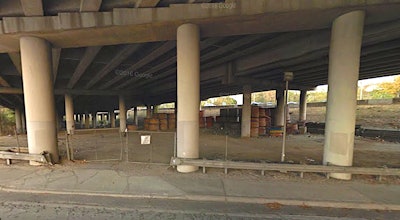 A Google Maps Street View image of astorage area underneath I-85 at Piedmont Road. Image: Google, November 2016
A Google Maps Street View image of astorage area underneath I-85 at Piedmont Road. Image: Google, November 2016The Georgia Department of Transportation failed to assess the fire risk of storing construction material underneath the Interstate 85 bridge near Atlanta that collapsed last spring, according to the National Transportation Safety Board in its new report on what caused the bridge’s demise.
The NTSB determined the probable cause of the collapse on I-85 was excessive heat after high-density polyethylene and fiberglass conduit stored underneath the bridge ignited. The material was ignited after a homeless man allegedly set a nearby chair on top of a shopping cart on fire. Basil Eleby has pleaded not guilty and is being treated in an 18-month court-ordered mental health program, which if successfully completed, the charges will be dropped.
The report said that a contributing factor to the fire was GDOT’s storing the materials under the bridge.
“The large amount of combustible material being stored underneath this section of the I-85 bridge increased the fire risk to the bridge,” the report said.
The material had come from a project that had been suspended in 2008. GDOT had been storing the 76 reels of polyethylene conduit and nine racks of fiberglass conduit at a different site, but later moved it under the bridge because the property was state-owned, fenced, out of the sun and near another GDOT facility. The materials were under the bridge for more than five years, the report said.
About an hour after firefighters arrived on the scene March 30 at about 6 p.m., the 92-foot-long bridge section collapsed. They continued fighting the fire until 11 a.m. the next day.
“Once ignited,” the report says, “the large quantity of combustible conduit material provided significant fuel to the incipient fire, resulting in an increase in the overall heat released by the fire.” That excessive heat also led 136 feet of adjacent bridge sections to lose pretension in reinforcement bars and show delamination and cracking throughout the bottom flanges.
GDOT ended up replacing 350 feet of the bridge within six weeks at a cost of $15 million. The bridge replacement project has been hailed nationally as a successful example of accelerated bridge construction.
Following the I-85 bridge collapse, the GDOT commissioner requested assistance from the Office of Insurance and Safety Fire Commissioner to conduct a statewide, joint agency review of DOT procedures for storing materials under bridges, among other issues, according to the report. From that, a task force of engineers and safety professionals from the Greater Atlanta Chapter of the Society of Fire Protection Engineers made recommendations based on National Fire Protection Association standards. One of the recommendations was that “the quantity, nature and burning characteristics (that is, heat release rate) of stored material must not exceed the design fire exposure that was considered during the structure’s design.”
In response to the NTSB report, GDOT acknowledged its failure concerning storage. The agency said in a statement that it changed its storage practices hours after the collapse to prohibit any storage of flammable or combustible materials under bridges. It also indicated it would take further action.
“Because Georgia DOT has committed to the public to develop a policy and procedure that further safeguards our infrastructure, we are pleased that – as expected – the report provides valuable guidance from subject-matter experts on how the department can shape future policies as they relate to storage of materials around and near infrastructure,” the statement says.
A GDOT spokeswoman told The Atlanta Journal-Constitution it is considering moving its Highway Emergency Response Operators (HERO) vehicles from underneath bridges.
GDOT also noted that it participated in the NTSB’s investigation and the preparation of its report. It also hoped the recommendations will help other state DOTs around the country:
“We are hopeful that these recommendations from the NTSB will be instrumental for other relevant agencies and Departments of Transportation across the country to prevent instances like this from happening elsewhere.”
The NTSB also hopes the collapse will serve as a warning across the country. After issuing the report, it released a nationwide safety alert calling on DOTs to be more vigilant concerning materials stored under bridges. It recommends states remove any materials underneath bridges that could pose a fire hazard; work with law enforcement to improve bridge surveillance; and restrict entry to storage areas to authorized personnel only.
“Although catastrophic fires fueled by materials stored underneath bridges are relatively rare events,” the alert says, “the loss of this structure demonstrates what can happen if bridge owners are not vigilant about monitoring and controlling such materials.”















